Are you ready to dive into the colorful world of paintball? If so, then you might have come across some intriguing rumors about the legality of red filling in paintballs. Picture this: you’re crouched down, paintball marker in hand, adrenaline pumping through your veins. You take aim at your opponent and fire, only to see a vibrant splash of red marking their defeat. But here’s the million-dollar question: is it legal to use red filling in paintballs? Well, fear not, fellow paintball enthusiasts, because today this article is going to uncover the truth behind this colorful controversy. Get ready to have your doubts cleared and your curiosity satiated as it navigates through the realm of legality in the paintball world.
Types of Paintballs and Their Calibers
Paintballs are one of the most essential components in paintball sports and choosing the right type and caliber can greatly affect your performance on the field. In this guide, we will discuss the different types of paintballs and their calibers to help you make an informed decision.
Types of Paintballs
There are three main types of paintballs available in the market: Oil-based, gelatin-based, and rubber-based. Each type has its own distinct characteristics that can affect its performance on the field.
Oil-based paintballs are the traditional type of paintballs used in the early days of paintball sports. These paintballs are made from oils or petroleum distillates and have a thick outer shell that is resistant to breaking. Due to their thick shell, they are less likely to break in the barrel of the gun or during storage. However, this also makes them more painful upon impact and can leave bruises on players.
Rubber-based paintballs are the newest type of paintballs in the market. They are made from a rubber-like material that is more durable and flexible than gelatin-based ones. This makes them ideal for rough terrains and extreme weather conditions. Rubber-based paintballs also have a lower chance of breaking in the barrel or during storage, making them a popular choice for tournament players.

Calibers of Paintballs
In addition to the type of paintballs, their caliber also plays a crucial role in their performance. Caliber refers to the size of the paintball, with most paintballs ranging from .50 to .68 caliber.
.50 caliber paintballs are the smallest and lightest among all calibers. They are mainly used for low-impact or beginner paintball games as they are less painful upon impact. These paintballs also have a lower velocity, making them ideal for indoor fields and close-quarter combat.
.68 caliber paintballs are the standard size used in most paintball games. They offer a good balance between speed and accuracy, making them suitable for both recreational and tournament play. These paintballs also have the widest range of options and are readily available in most stores.
Apart from .50 and .68 calibers, there are other paintball sizes available in the market, such as .43 caliber and .43 caliber. These smaller calibers are usually used for specialized types of gameplay or for specific types of paintball guns [1].
What are paintballs filled with?
Paintballs are small spherical capsules that are used in paintball games. They are designed to burst upon impact, leaving a bright colored mark on the target. But have you ever wondered what these tiny projectiles are filled with?
Traditionally, paintballs were made from oil-based paints and animal fat, which was not only toxic but also hurt when they hit their targets. However, with the advancements in technology and safety concerns, paintballs now have a much safer and more environmentally friendly filling.
The most common type of paintball fill nowadays is made from water-soluble, non-toxic polyethylene glycol (PEG). This gel-like substance is biodegradable and safe for both humans and the environment. It is also used in various other products such as toothpaste, cosmetics, and medications.
Another popular type of paintball fill is made from cornstarch. This biodegradable option is also non-toxic and safe for the environment. However, its consistency can be affected by moisture, making it less reliable in certain weather conditions.
Some companies have also started using a mixture of PEG and cornstarch to create a paintball fill that combines the strengths of both materials. This hybrid filling is becoming increasingly popular due to its superior consistency and environmental friendliness.
In addition to these environmentally friendly options, some companies have also experimented with using food-based ingredients as paintball fills. These include substances like sugar or vegetable oil, which are completely safe for humans and the environment. However, these types of fills are still in the early stages of development and are not widely available yet.
In conclusion, paintballs today are filled with safe and environmentally friendly materials like PEG, cornstarch, and sometimes even food-based ingredients. This is a huge improvement from the toxic and harmful substances used in the past. Whether you are a seasoned paintball player or a beginner, you can rest assured that the paintballs used in your games are not only effective but also safe for everyone involved [2].
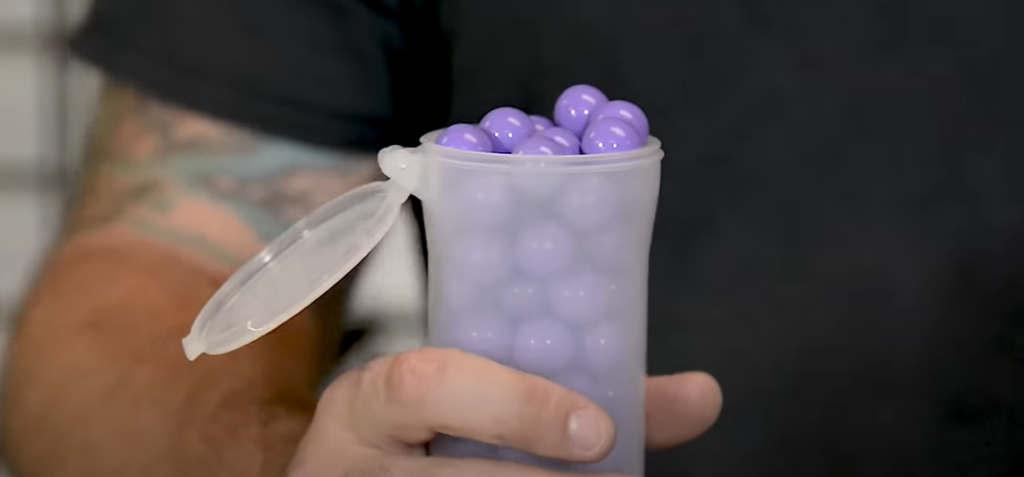
Do Some Types of Paintballs Stain More Than Others?
Paintball Dye
Paintballs are not just for marking opponents on the field, they now come in various colors and types. Players choose paintballs based on their preference or game type. However, it’s important to consider the staining potential of different types. Some dyes may stain more due to ingredients and process. Most paintballs are made with water, gelatin, and food coloring, easily washing off skin and clothing. However, some manufacturers use oil-based or permanent dyes, which can be harder to remove.
Paintball Quality
Another factor that may affect staining is the quality of the paintball itself. Higher quality paintballs are typically made with thicker shells and stronger fill, resulting in less breakage upon impact. This means there will be less paint to potentially stain surfaces. The quality of paintballs can also depend on storage and handling. If paintballs are exposed to extreme temperatures or mishandled, it may cause them to become brittle or swell, leading to more breakage and potential staining.
Paintball Date of Manufacture
The date of manufacture can also play a role in the staining ability of paintballs. Paintballs that are older or have been sitting on shelves for a longer period of time tend to become softer and more prone to breakage, resulting in more staining. It’s important for players to check the expiration date of paintballs before purchasing them.
Is Red Filling in Paintballs Illegal?
Paintball is a popular recreational sport where players try to eliminate their opponents by shooting them with paint-filled pellets. The use of paintballs has been around since the 1970s and has gained popularity in recent years. However, there have been controversies surrounding the legality of using red filling in paintballs.
Why Red Filling?
Red filling, with its vivid hue, is undeniably one of the most commonly utilized colors in the thrilling sport of paintball. Its vibrant shade serves a crucial purpose, ensuring that players can effortlessly discern whether they have been struck or not. Furthermore, the association of red fillings with blood adds an extra layer of realism to the game, immersing players in a truly exhilarating and lifelike experience.
In the world of paintball, red filling stands as a symbol of both visibility and intensity, adding an element of intrigue and anticipation to every shot fired and every victory achieved. So, grab your gear, load up those red-filled paintballs, and prepare for an adventure that will leave you breathless and craving for more.

Safety Concerns
Some people argue that using red filling in paintballs can be dangerous as it may cause confusion and panic among players. When players are hit, the red dye may splatter on their clothes, making it seem like they are bleeding. This can lead to unnecessary aggression and conflicts among players, potentially escalating the intensity of the game. Moreover, since the game involves running around and strategically hiding behind obstacles, there is a constant risk of accidentally ingesting or getting the dye in one’s eyes, which could cause discomfort or even temporary impairment of vision. It is crucial for paintball arenas and players to be aware of these potential risks and take appropriate safety measures to ensure a fun and safe gaming experience for everyone involved.
Legal Implications
Using red filling in paintballs is not explicitly prohibited by law, but it can lead to legal complications depending on the context. Some states or countries have regulations regarding the use of red dye in public spaces, due to safety concerns and the potential for confusion. Players and field owners should carefully consider these factors and comply with applicable laws to avoid unintended consequences.
Alternatives to Red Filling
To avoid any potential safety concerns or legal implications, some paintball fields have opted for alternative colors such as yellow or orange. These colors are still highly visible but do not evoke the same psychological response as red filling. Additionally, there are also options for biodegradable and non-toxic fillings, which not only address safety concerns but also have a lower impact on the environment [3].
How Do You Clean Paintball Stains?
Paintball is a fun and exciting sport that many people enjoy. However, cleaning up after a paintball game can be quite a task, especially when dealing with stubborn paintball stains. These stains can be tough to remove and require special care to ensure they don’t ruin your clothes or equipment. Here are some tips and tricks on how to effectively remove paintball stains from your clothing and gear.
First, you should understand what causes paintball stains. Paintballs are made of a mixture of dye, water, and gelatin, which is designed to burst on impact. The dye in the paintball is the main culprit behind those stubborn stains. The longer you leave the stain untreated, the harder it will be to remove.
To clean paintball stains off your clothes, follow these steps:
- Soak the stained area in cold water as soon as possible. This will prevent the stain from setting in.
- Wash the garment with a pre-treatment stain remover or regular detergent on a gentle cycle.
- Check to see if the stain has been removed before drying the garment. If not, repeat the process until it is completely gone.
- If the stain persists, mix a solution of equal parts white vinegar and water and soak the garment for an hour before washing again.
- For stubborn stains, you can also try using rubbing alcohol or hairspray on the stained area before washing.
To clean paintball stains off your gear, follow these steps:
- Wipe off any excess paint with a damp cloth.
- Mix warm water and mild soap in a bucket and use a soft-bristled brush to scrub the stained area.
- Rinse the gear with clean water and dry it thoroughly.
- For tougher stains, you can use a specialized cleaner made specifically for paintball equipment.
It’s also important to note that prevention is key when it comes to avoiding paintball stains. Wearing protective clothing, such as a paintball jersey or coveralls, can help minimize the chances of getting stained. Additionally, regularly cleaning and maintaining your gear can also prevent stubborn stains from setting in.

FAQ
Is paintball illegal in the UK?
No, paintball is not illegal in the UK. In fact, it is a widely embraced recreational activity enjoyed by both adults and children alike. With its thrilling and adrenaline-pumping nature, paintball provides an exhilarating experience as players strategize, unleash their competitive spirit, and engage in friendly battles within specially designed arenas. Whether it’s a group outing, team-building event, or simply a day of fun, paintball offers a unique and memorable adventure for participants of all ages. So grab your gear, gather your friends, and get ready for an action-packed day of paintball excitement!
Do I need a license to play paintball?
No, you do not need a license to play paintball in the UK. However, some paintball fields may require players to sign a waiver or have parental consent if they are under the age of 18. It is always best to check with the specific venue you plan on visiting to see if there are any additional requirements or regulations in place.
Useful Video: Paintball Rental Guns Should Be ILLEGAL
Conclusion Paragraph
So, red filling in paintballs is not a myth – it’s a real thing! And now, you know more about the science behind it. Paintball is an exciting and adrenaline-fueled sport that has been gaining popularity over the years. The use of red filling in paintballs adds an extra layer of excitement to the game, making it even more thrilling for players. But beyond just being visually appealing, a red filling has some practical purposes as well. For example, it helps players easily see when they have been hit, making the game more fair and transparent. Moreover, the use of red filling also has some psychological effects on players. The color red is often associated with danger and evokes a fight-or-flight response in humans. This can add to the intensity of the game and make it feel even more realistic for players.
References:
- https://cypresspaintball.com/types-of-paintballs-and-calibers/
- https://paintball4all.com/what-are-paintballs-made-of/
- https://paintballhive.com/updated-are-red-paintballs-illegal-2022-the-real-truth/


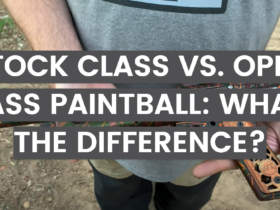


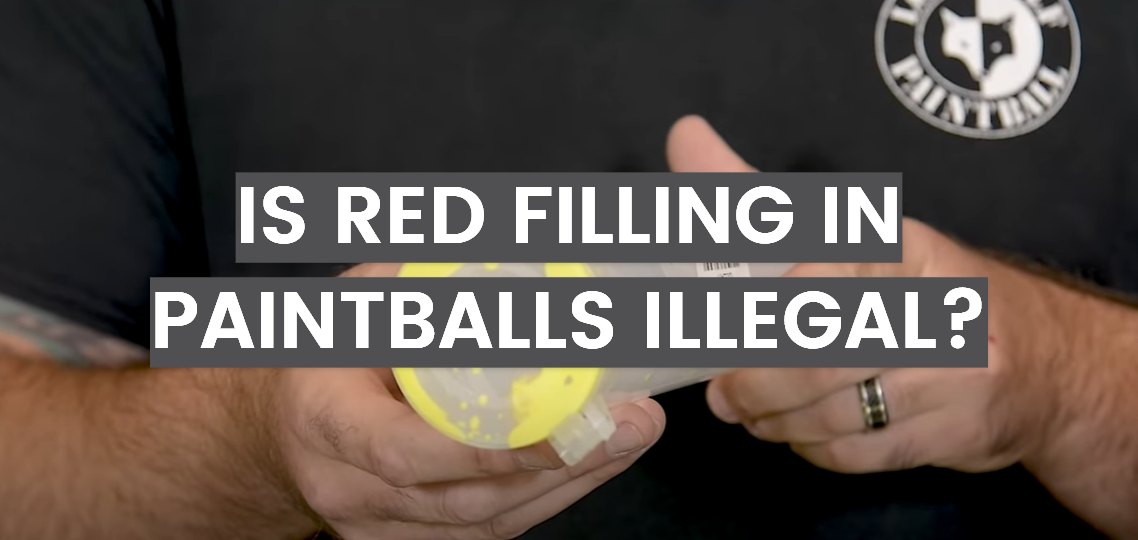

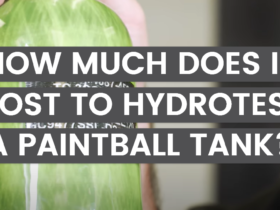
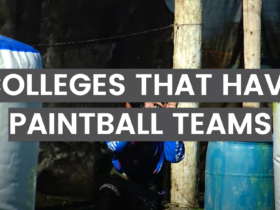
Leave a Review